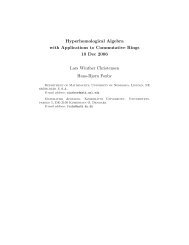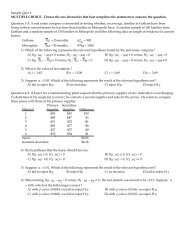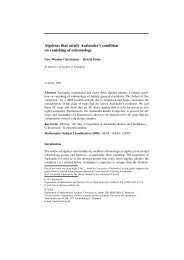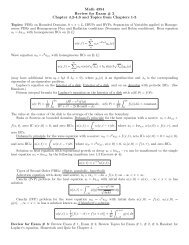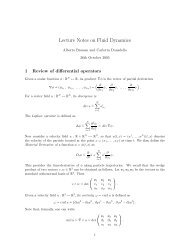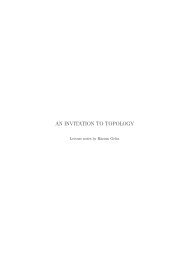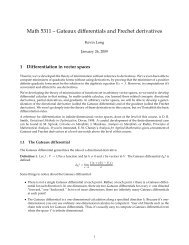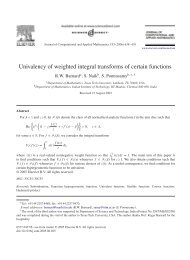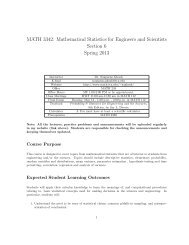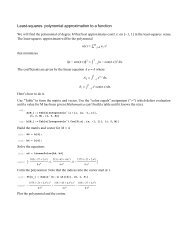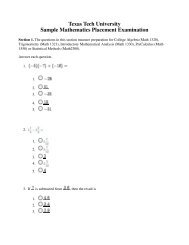QUANTUM MECHANICS AND NON-ABELIAN THETA FUNCTIONS ...
QUANTUM MECHANICS AND NON-ABELIAN THETA FUNCTIONS ...
QUANTUM MECHANICS AND NON-ABELIAN THETA FUNCTIONS ...
Create successful ePaper yourself
Turn your PDF publications into a flip-book with our unique Google optimized e-Paper software.
<strong>QUANTUM</strong> <strong>MECHANICS</strong> <strong>AND</strong> GENERALIZED <strong>THETA</strong> <strong>FUNCTIONS</strong> 11Proposition 3.1. The set of elements in H(Z) that act on theta functionsas identity operators is a normal subgroup consisting of the Nth powers ofelements of the form exp(pP + qQ + kE) with k even. The quotient groupis a finite Heisenberg group.Proof. Ifexp(pP + qQ + kE)θ τ jπi= e− N pq−2πi πiqj+ N N k θj+pτequals θj τ for all j, then p is a multiple of N. Setting j = N 2, we concludethat k is a multiple of 2N. Finally, because −2q(j + N 2) must be an multipleof 2N for all j, it follows that q must be a multiple of N. It is not hard tosee that any such element is the Nth power of an element with the thirdentry even. The computation(exp(pP + qQ + kE)) N θ τ jN(N−1)= e−2πijq−2πi 2Npq−N πipq πik+N N N θj+Nτ= e −2πijq−πiNpq+πik θ τ j = e πik θ τ jshows that the Nth powers of elements with third entry even act as theidentity operator. This proves the first part of the statement.Next, define the finite Heisenberg groupby the multiplication ruleH(Z N ) = {(p,q,k), p,q ∈ Z N ,k ∈ Z 2N }(p,q,k)(p ′ ,q ′ ,k ′ ) = (p + p ′ ,q + q ′ ,k + k ′ + pq ′ ).It is straightforward to check that the mapφ((p,q,k)) = (p,q,k + pq)is a group homomorphism whose kernel is the set of elements of the formexp(pP +qQ+kE) with p and q divisible by N and k divisible by 2N. Hencethe desired quotient group is isomorphic to a finite Heisenberg group. □From now on we will denote by H(Z N ) the quotient of the Heisenberg withinteger entries defined in the previous proposition. Whenever we mentionthe finite Heisenberg group, we have in mind this group. We have seenthat indeed, this group is isomorphic to an actual finite Heisenberg group,but we do not work with the latter, because for example the bilinear form((p,q),(p ′ ,q ′ )) → pq ′ which defines multiplication is not invariant undersymplectomorphisms. Thus whenever we work with an exponential of theform exp(pP +qQ+kE), we think of it as the equivalence class of the element(p,q,k) ∈ H(Z).Theorem (Stone-von Neumann) The Schrödinger representation of H(Z N )is the unique irreducible unitary representation of this group with the propertythat exp(kE) acts as e πiN k Id for all k ∈ Z.



